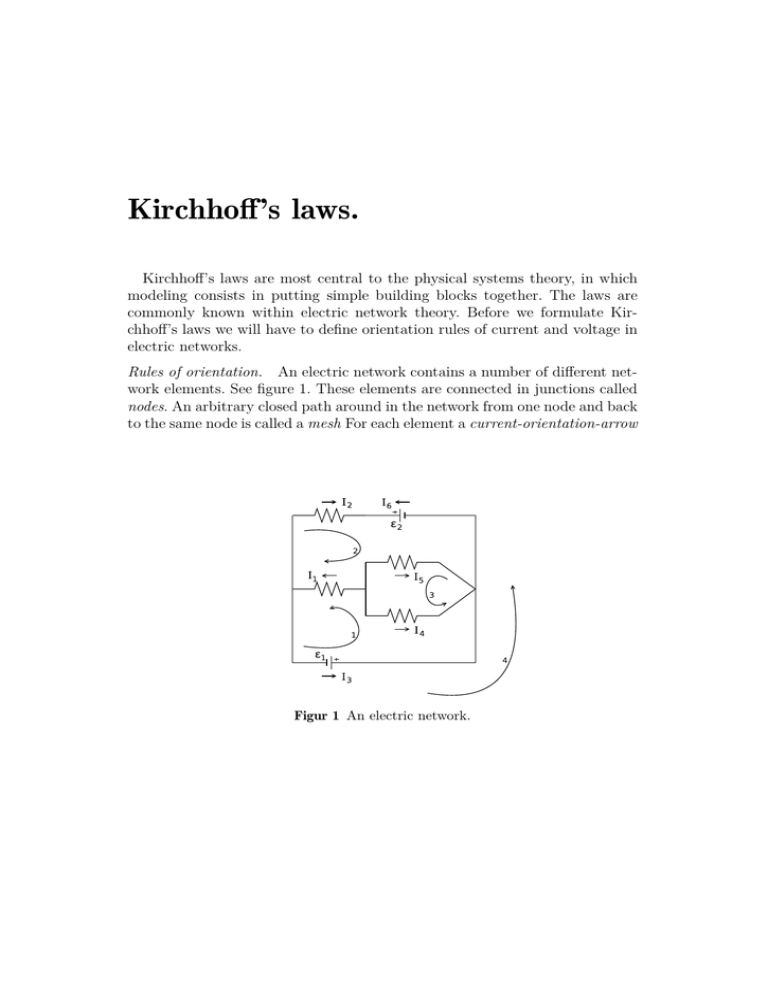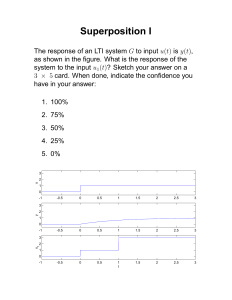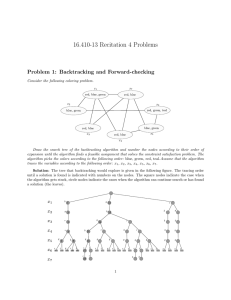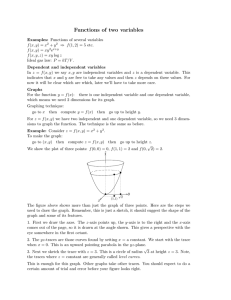Kirchhoff's Laws: Network Analysis & Circuit Theory
advertisement

Kirchhoff’s laws. Kirchhoff’s laws are most central to the physical systems theory, in which modeling consists in putting simple building blocks together. The laws are commonly known within electric network theory. Before we formulate Kirchhoff’s laws we will have to define orientation rules of current and voltage in electric networks. Rules of orientation. An electric network contains a number of different network elements. See figure 1. These elements are connected in junctions called nodes. An arbitrary closed path around in the network from one node and back to the same node is called a mesh For each element a current-orientation-arrow Figur 1 An electric network. is drawn and a symbol I for the value of the current. A positive value of I means that the actual physical current goes in the direction of the arrow. A negative value of I means that the actual physical current goes in opposite direction. One is free to consider the element as an (energy) source or consumer. If it is a source, the increment of the potential in the direction of the flow is called an electromotive force . One may put a plus sign, + beside the wire near the arrow head to indicate that if is positiv the potential is largest here. If the element is considered a user we have rather a potential drop U in the direction of the arrow. One may put a plus sign, + beside the wire near the arrow tail to indicate that if U is positive the potential is largest here. For each mesh a mesh-orientation-arrow is drawn. This tells the direction in which electromotoric forces and voltage drops are added in the mesh-law (see below). Notice that for complex networks like the one in figure 1 one cannot allways choose mesh- and current orientation in the same direction. Kirchhoff’s laws. There are two laws 1) The node (or current) law. The sum of currents towards a node is 0. 2) The mesh (or voltage) law. The sum of the electromotive forces are equal to the sum of voltage drops around a mesh. For both laws 1) and 2) it as assumed that if you go against the chosen current direction of a specific element you should instead subtract the corresponding current or voltage. In the example figure 1 we denote Un the voltage drop across the resistor with the current In and have, mesh 1: 1 = −U4 + U1 mesh 2: −2 = −U5 + U1 + U2 mesh 3: 0 = −U5 + U4 mesh 4: 1 + 2 = −U2 There are more meshes. Choose an orientation of these and write up the mesh equations. Examples of some node equations for the network are I2 + I6 = 0, I1 − I2 − I3 = 0, I3 + I4 + I5 − I6 = 0 In order to illustrate the use of Kirchhoff’s laws we will derive the wellknown rules of calculating the resulting resistance of respectively a series and parallel connection of two resistors. 2 Figur 2 Two resistors connected in series. Series connection. From figure 2 we find the node equations k1 : I − I1 = 0 k2 : I1 − I2 = 0 and the mesh equation m : = U1 + U2 The node equations leads to I = I1 = I2 and the mesh equation combined with Ohm’s law yields = R1 I1 + R2 I2 = R1 I + R2 I = (R1 + R2 )I Seen from the viewpoint of the source the two resistances thus can be replaced by one, R of the value, R = R1 + R2 Parallel connection. From figure 3 we find the nodal equation, k : I − I1 − I2 = 0 and the mesh equations m1 : = U1 m2 : = U2 Combining these with Ohm’s lov yields hhv = R1 I1 , /R1 , I2 = /R2 . Next the node eqution gives, I = I1 + I2 = 1 1 + =( + ) R1 R2 R1 R2 3 = R2 I2 or I1 = Figur 3 Two resistors in parallel Written in the form = 1 R1 1 + 1 R2 I we see, that the replacement resistance is R= 1 R1 1 + 1 R2 The reciprocal of a resistance is called a conductivity, Λ = 1/R. In terms of the conductivities, we may rather say that conductivites are additive for a parallel connection. That is Λ = Λ1 + Λ2 where Λ = 1/R, Λ1 = 1/R1 , Λ2 = 1/R2 . A less trivial example is the replacement resistance of a Wheatstone bridge, that wee shall consider in the exercises. Exercise 1: Four resistors, R1 = 25Ω, R2 = 15Ω, R3 = 40Ω and R4 = 20Ω are connected to an element of 12V as shown in figure 4. Calculate the total resistance of the four resistors. Find the current in each resistor. Exercise 2: Consider the circuit of figure 5. Which value of R2 would give a current of 2A through it when 1 = 6.0V, 2 = 10.0V and R1 = 2.0Ω? Exercise 3: Two elements of the same electromotoric force , but with different inner resitances, Ri og Ri0 are put in in parallel and connected to an outer resistance R. Find the current through each element. 4 Figur 4 Figur 5 Exercise 4: Find the currents through the two resistors of figure 6. The resistances are R1 = 10.0Ω and R2 = 8.0Ω and the electromotoric forces 1 = 10.0V and 2 = 12.0V. What power is delivered by the 12-V element? Figur 6 Exercise 5: Consider the circuit of figure 7. The resistances are R1 = 4.0Ω, R2 = 4.0Ω and R3 = 2.0Ω. The electromotive force of the element 2 is 2 = 8.0V. What should be the electromotoric force 1 of the element 1 if element 2 is supposed to be charged? Exercise 6: Two elements with inner resistances are connected as in 5 Figur 7 figure 8. Assuming R1 = 0.50Ω, R2 = 0.20Ω, = 12.0V og 0 = 6.0V, Ri = 0.025Ω, Ri0 = 0.020Ω, find the currents through R1 og R2 . Figur 8 Exercise 7: Five resistors R1 = 2.0kΩ, R2 = 4.0kΩ, R3 = 6.0kΩ, R4 = 2.0kΩ og R5 = 3.0kΩ are connected to a 12V element as shown in figure 9. Calculate the current in each resistor. Find the difference in potential between the points P and P’? Exercise 8: Two elements of 1 = 6.0V and 2 = 3.0V are connected to three resistors, R1 = 6.0Ω, R2 = 4.0Ω and R3 = 2.0Ω, as shown in figure 10. Calculate the current in each resistor and each element. 6 Figur 9 Figur 10 7





